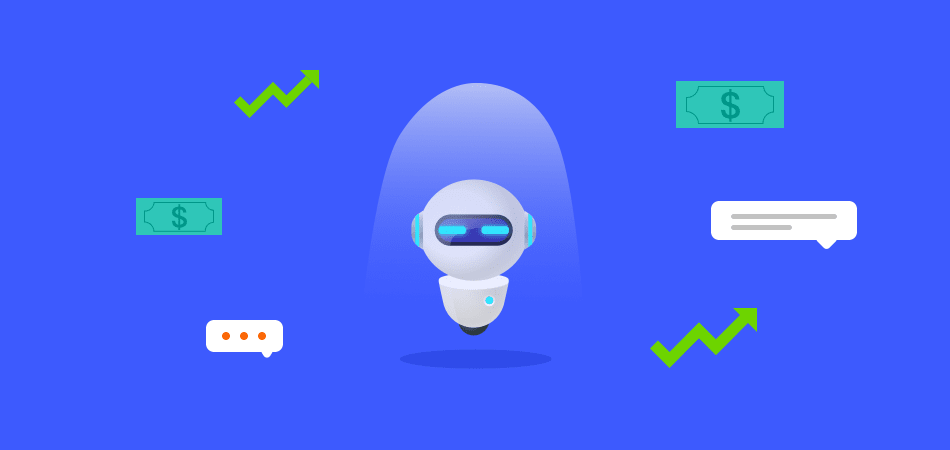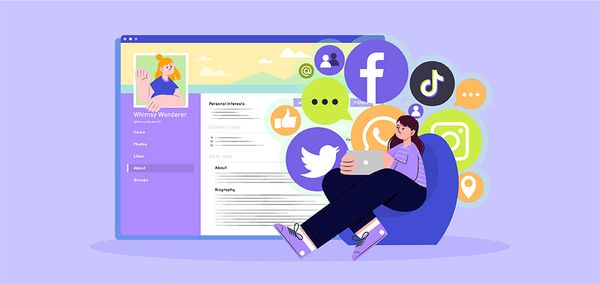7 Ways AI Is Revolutionizing Lead Generation

Lead generation is crucial for business sustainability and growth. But it is no easy feat.
Sometimes it feels like you are throwing spaghetti at the wall and praying that something will stick.
Traditional methods of lead generation are time-consuming, expensive, and often leave you with low-quality leads that don't convert. These are all problems that artificial intelligence (AI) is helping to solve.
The technological revolution is changing everything. It's not just about virtual assistants — it's about using technology to understand customers and build relationships. It's about helping you understand how to reach customers who are looking for your product or service and how to talk about it in a way that resonates with them.
And that means that old-school lead generation strategies are falling by the wayside. In their place come new ways of thinking, understanding who your audience is, reaching out to them, and converting leads into customers.
Artificial intelligence, machine learning, and automated workflows are bringing a new level of efficiency to lead generation campaigns, saving you time and money.
In this post, we'll explore how AI is revolutionizing lead generation and some best practices for getting started.
Let's dive in.
7 Ways AI Is Revolutionizing Lead Generation
1. Customer Insights
Your customers hold the key to everything you need to know about how to run a successful business. But it can be hard to find the time to dive into their social feeds or keep up with them.
AI helps us gather customer insights in a way that's quick and easy. Most importantly, this allows you to spend more time talking with customers and responding to their needs.
Here are three ways you can use AI to gather user insights:
- Automatically analyze customer feedback across all platforms. AI can read through your social media channels, emails, and even customer service calls and highlight areas where there might be some confusion or frustration among users.
- Spot trends in user behavior by tracking user actions over time — like purchases or website visits — to see what works best for different types of users.
- Pinpoint problems as they happen by tracking user sessions online and alerting you when something doesn't look right.
2. Lead Scoring
Lead scoring is an integral part of the lead generation process. It is a way to measure the level of interest a prospect has in your business, the likelihood they'll purchase from you, and their potential value as a customer.
A landing page may features more than one different call-to-action button. Fore example:
- Buy now
- Learn more
We have assigned a lead score of +10 to the "Buy now" CTA and +5 to the "Learn more" CTA. Now, what does that mean?
People who click on “Buy now” are clearly interested in buying the product than those who just click on the "Learn more" button.
But unfortunately, keeping track of all your leads, especially across channels, can quickly become an impossible task that leaves you frustrated and stressed out. But it doesn't have to be that way. A lead-scoring AI platform can process data from multiple sources, like web traffic, social media, sales calls, and email campaigns.
The automated process helps in many ways:
- Remove bias.
- Identify leads that might not have been considered.
- Helps salespeople focus on the most promising prospects and avoid wasting time on those who aren't worth their time.
- Improve lead scoring accuracy by using data-driven insights that help identify prospects likely to convert into customers.
If you're trying to convert leads into customers, you want to prioritize the ones who are likely to convert. AI can help you prioritize leads based on how much they have interacted with your brand, website, and social media pages. This way, when a new lead comes in, it'll automatically filter on their level of engagement with your brand and pass on for further processing.
You don't want to waste time chasing down leads who'll never buy from you — or, even worse, won't even click your CTA or fill out a form. Lead generation software uses artificial intelligence to focus on prospects who are interested in what your company has to offer.
The more accurate your lead scoring, the better you can target your marketing campaigns and increase conversions.
3. Chatbots
A chatbot is a software that simulates a conversation with a human, allowing your customers to interact with it just as they would another person. And the best part of all? They're available 24/7.
Using chatbots saves time and money by not hiring extra staff. The customer can communicate through multiple channels, such as SMS or online chat.
Chatbots are a relatively new tool for lead generation, but they already provide several key benefits that can help you get more leads.
| Get Started Now to Grow Your Online Business with the Best AliExpress Dropshipping Tool - DSers! |
Chatbots are helpful for lead generation because they allow you to automate your information-gathering process. They can be programmed to ask questions about what the user is looking for and then use that information to provide the information they need. Chatbots can collect the information you need without having to pay someone to manually enter it into your system.
Also, you can easily direct users to specific parts of your website or app by asking them questions and directing them based on their answers. For example, if a user indicates that they are interested in learning more about a certain topic, then the chatbot could refer them to a page where they can read use cases or understand its’ benefits.
They won't replace humans (yet), but they can often make it easier to generate leads by automating parts of the sales process and by giving users access to more information.
4. Content Generation
Content is king. After all, inbound marketing is built on using content to attract attention and generate leads. But man, doesn't it put a significant drain on resources?
So how do you find copywriters that can write quality content at scale? Unfortunately, they don't grow on trees. Sigh.
That's where AI comes in. Today's AI writer tool like Simplified allow you to generate personalized emails tailored to each prospect's needs. Thus, informing each prospect with precisely what they need to meet their needs and thereby generating higher conversions.
56% of content marketers say their top challenge in creating high-quality content is lack of time.
With the help of AI, say goodbye to stressing over your next 2,000-word article. And say hello to high-quality content that not only ranks well but doesn't take you two weeks to write.
AI can understand trends and patterns, so it can create timely, relevant, helpful, and engaging content in a fraction of the time.
If you're looking to take your content to the next level, consider incorporating text-to-speech technology into your production process by creating videos for your content plan. With their natural-sounding voices and advanced language capabilities, you can create engaging and captivating videos.
5. Personalization
Personalization is an effective way to engage and delight customers, with 80% of consumers being more likely to buy from a company that offers a tailored experience.
Personalization doesn't necessarily mean you have to create a unique experience for each prospect. But it does mean you need to understand who they are as individuals so that you can deliver a message that resonates with them.
For example, suppose a bank wanted find qualified applicants for a new line of prepaid debit cards for teens. In that case, they could use artificial intelligence systems to comb through their existing consumer base and identify customers who are likely to have children. This could include customers over 25, customers who are married, or customers who recently contributed to a 529 plan.
And that's not all. AI tools can send highly relevant content to these segmented leads, spiking interest in your business and ultimately driving conversions.
6. Predictive Analytics and Prospect Profiling
AI can help you generate more leads by making use of predictive analytics. Predictive analytics is the practice of using historical data to predict future outcomes and trends.
Prediction models are common in marketing and advertising. Companies use models to find out who their ideal customers are, what products they want to buy, what messaging will resonate with them, and where those customers live so they can target them with ads on social media or other digital channels.
You can train AI systems to create customer profiles based on your buyer's past behavior. This technology makes accurate predictions about potential leads based on real data and removes the possibility of human error.
Prospects aren't all the same, so you need to understand who your audience is and how they behave. AI is your best friend when it's time to find the right prospects, marketing messages, channels, time, and offers.
When AI is integrated with your CDP infrastructure, the potential to use your data becomes exponential.
AI will be able to analyze and predict trends based on the information in your CDP to predict customer churn before it happens, focus ad spend on leads that are more likely to convert, and even save discounts and coupons for customers that will be positively impacted by them.
7. Automation Marketing Processes
Automation helps remove bottlenecks in your workflow by funneling high-quality leads down the pipeline without the need for an agent or salesperson to intervene. Implementing sales automation processes can 10x your lead generation efforts.
Credit card rewards have always been a key motivational driver for consumers to spend money. The idea here is to stockpile as many rewards as possible while only spending money on items that you'd already purchase regardless. Let's take a look at this sales automation process in action.
If you rinse and repeat this process, there comes a time where you've earned enough points for a free Apple Watch or a honeymoon to Hawaii. The problem is, how do you redeem these points and exchange them for the proper value? And more specifically, how do businesses target these customers that have a wealth of credit card points?
The great thing about marketing automation and AI is that they work simultaneously to help you find and target the right people with your marketing message. That means you can reach the right person at the right time. It's not enough for an AI platform to analyze data — it also needs to analyze human behavior so that it can make predictions about what types of messages will resonate most with your audience.
Using AI, companies can understand what credit cards appeal to each person based on their spending habits and the current credit cards in their wallet.
Now you have a steady flow of high-quality leads receiving the most relevant information for their specific credit cards and something they're interested in using during their online shopping experience.
Does that sound too good to be true? Maybe you're worried about consumer privacy in the marketing automation process?
Don't worry. AI data solutions, like synthetic data generation, can help big enterprises acquire high-quality customer data while also maintaining data privacy compliance. The last thing you want is a lawsuit on your hands.
Wrapping up
Artificial intelligence is truly a game-changer for lead generation. It can help you generate more leads, better qualify them, find prospects that match your ideal customer profile, and automate many marketing processes.
But don't forget to stay on top of the current AI practices and techniques to continue to streamline your business and use AI in the most effective ways. There are plenty of free libraries or platforms that offer educational material on many topics that’ll keep you motivated and striving for long-term business success.
AI is here to stay. It's time to adapt to gain a competitive edge or let your business fall to the back of the pack. The choice is up to you.
About the Author
Guillaume is a digital marketer focused on handling the outreach strategy at uSERP and content management at Wordable. Outside of work, he enjoys his expat life in sunny Mexico, reading books, wandering around and catching the latest shows on TV.












 Company
Company
 Why Choose DSers
Why Choose DSers
 Blog
Blog
 Help Center
Help Center




 Live Chat
Live Chat